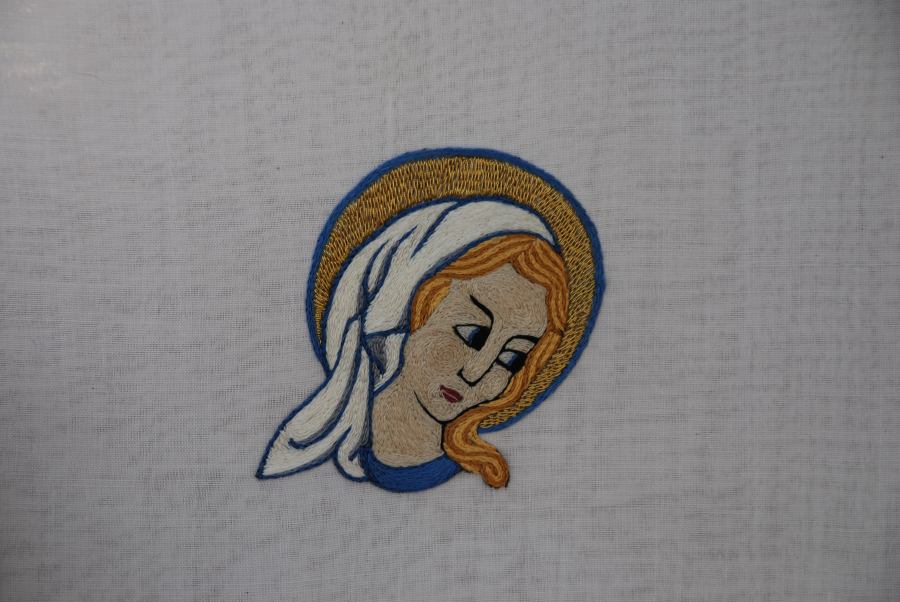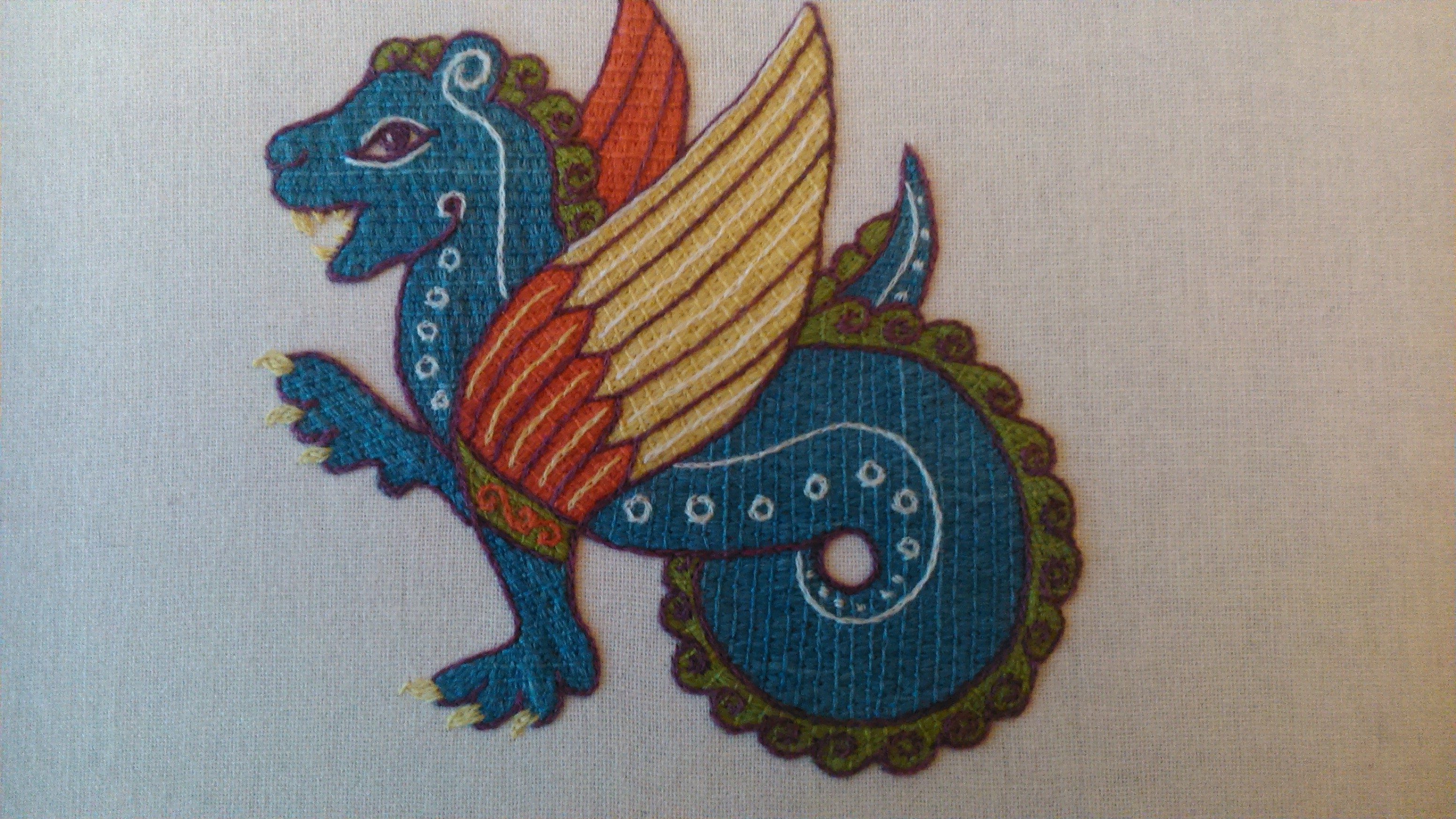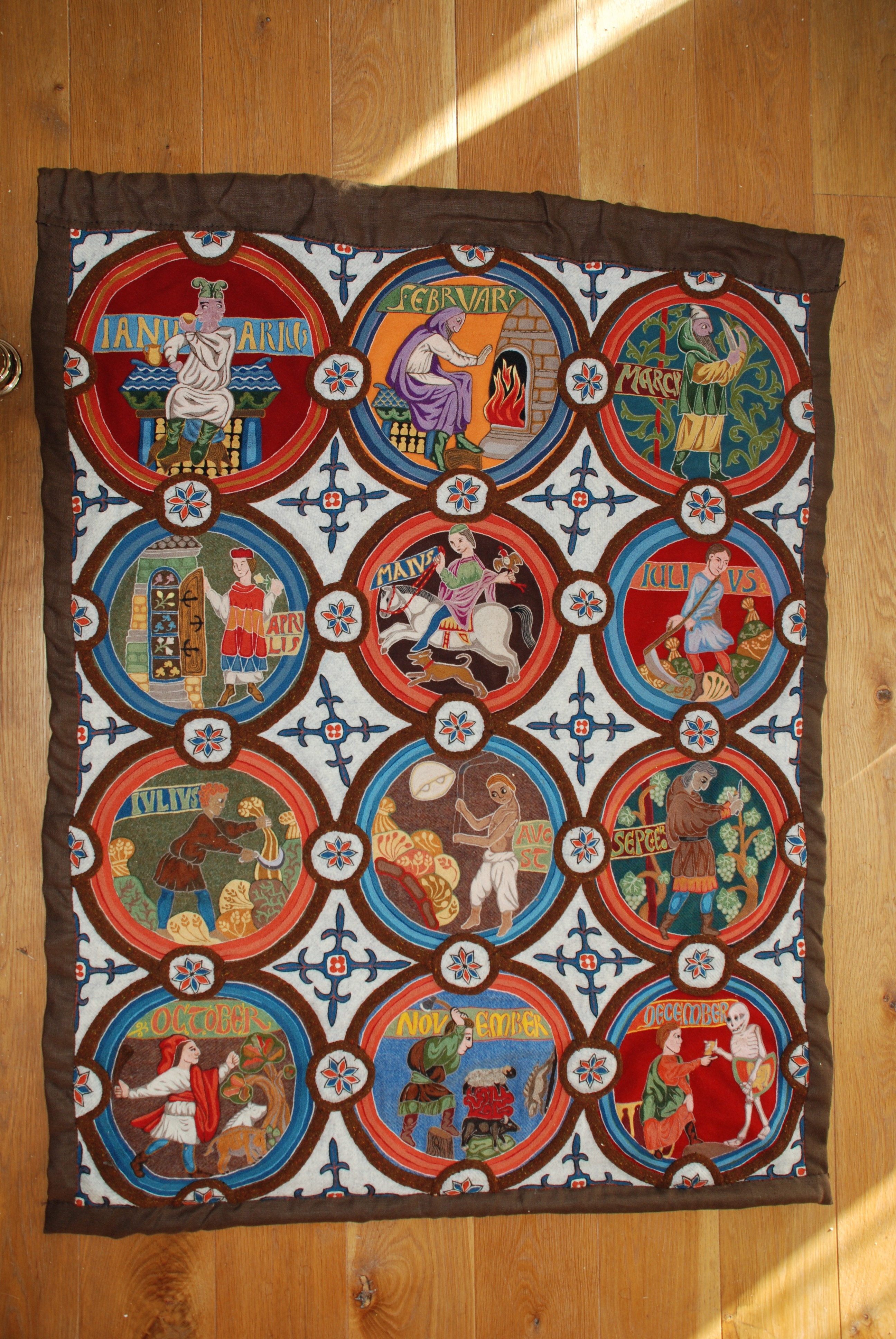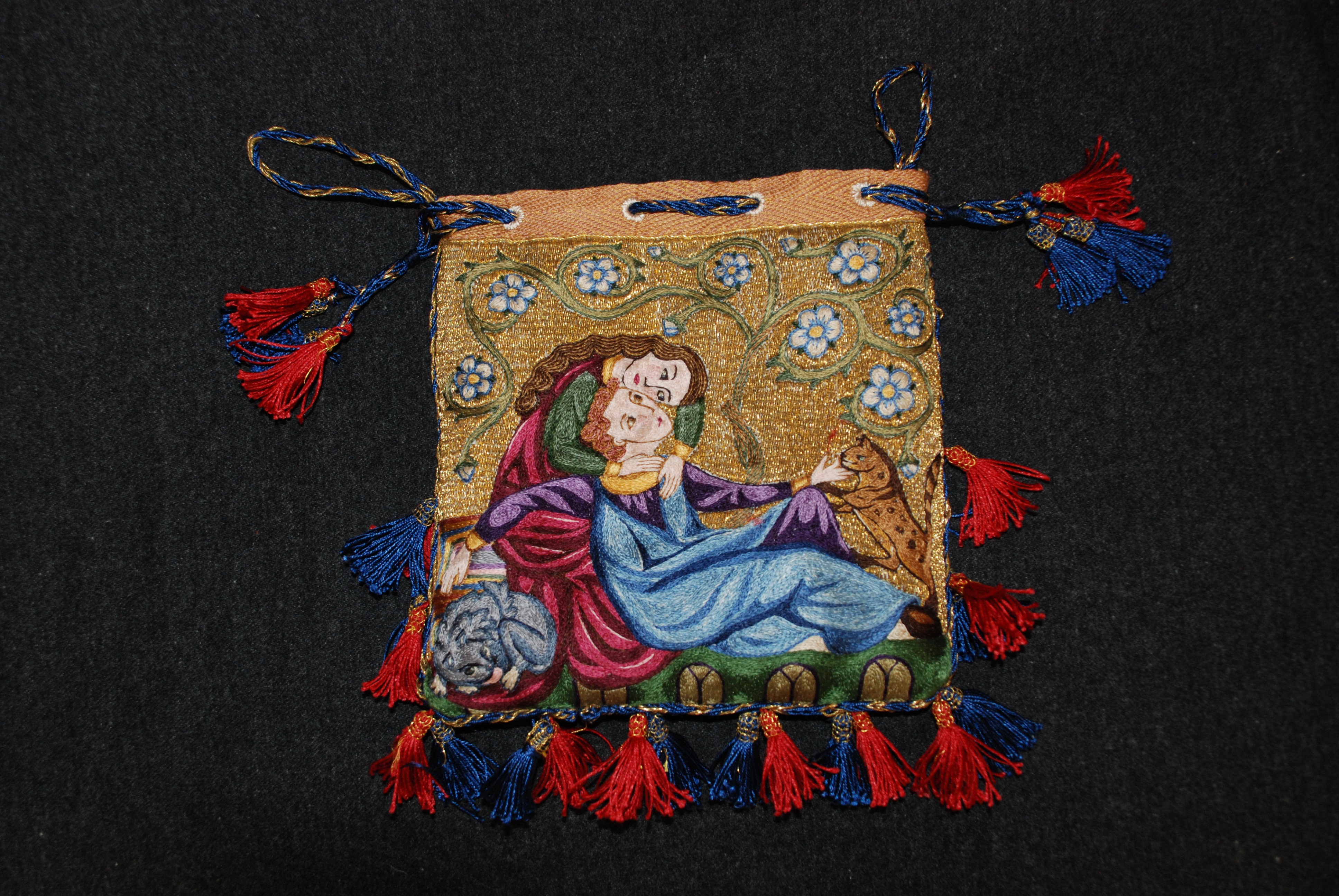dye
Madder dyed this weekend for finishing the antependium.
This actually answered a question I’d had when I did the original batch of dyes for this project. You see, I got my best ever madder red, and wondered to what extent the colour was due to the quality of dye I’d used, and to what extent due to the thread itself. So, when I found I needed to try and match the colour I fished out the last two skiens of white wool that I’d left undyed for the background of the panels (I wanted the thread to match as well as the colour) as well as sorting out some skiens of the new wool I found at Texere in summer (the new stuff is a much nicer texture as it’s almost identical to Appletons crewel)
On the left is what remains of the original dye batch, and in the middle is a skein of the same thread from the new batch. As you can see the colour almost matches – I think the camera doesn’t quite show the discrepancy as much as the naked eye can see it, but its near enough as makes no difference in terms of Medieval embroidery, since the originals tend to have wide variations in shade due to the natural dyes used(although I’m sure it would be an absolute tragedy in terms of more modern work)
On the right is a skien of the new wool from Texere, which was dyed in the same bath for the same amount of time, and as you can see the colour variation is huge!
This really makes me curious. I’m fairly certain that the original antependium wool was lightly bleached, whereas the Texere stuff looks more of a natural unbleached sheepy sort of white. I’m now very tempted to try bleaching some of the Texere wool before I do my next big dye fest in spring so I can see how much of a difference it makes.
Several people have asked recently how difficult it is to dye your own wools, and the answer is, not very. I always say that if you can make soup you can dye. Ok, so I’m my usual slapdash self with dyeing, and I’m sure if Gareth was doing it he’d go all nerdy scientist and wiegh everything really precisely and keep a record book of times and quanitities, but I just can’t be faffed with all that.
The dyes I’m discussing here are natural, and the same holds true for all colours with the exception of blue, which is far more complicated, and a whole other article.
The only area where you really need to be precise about wieghts is when you mordant your yarn. The mordant is a type of chemical glue that allows the pigment to adhere to the dye, and it also influences the resulting colour – iron darkens, tin brightens.
The main mordants are tin, chrome, iron, copper and alum. I mainly use alum, partly becuase its the main historically used mordant, and partly because its whole lot less poisonous than the others. Also because I think it gives a cleaner colour that reflects the dye rather than the mordant.
All mordants need to be treated with care. Too little and your colour can be patchy, too much and the yarn can become sticky, hard, or even fall apart.
You can mordant at the end – often used when you want the mordant to change the colour, or during dyeing – useful if you want a quick result, or before dyeing.
I normally pre-mordant, as it allows me to mordant all the yarn evenly, then divide it up and use it with different dyes, rather than having to measure the mordant out individually for each dyepot. It’s basically the lazy option, and given the choice I will always take the lazy option because I’m an idle cow at heart.
You need to dedicate a large pot (preferably a nice big stock pot) and a stirring spoon (a metal one is best, as a wooden spoon can transfer colour to the next thing you use it on). You really don’t want to use anything you’re going to cook with. Rubber gloves are good. I use my kitchen, I eat takeaways when I’m dyeing and clean the kitchen thouroughly once I’m done, just to be on the safe side.
For one pound of wool(dry wieght), use 3oz alum and 1oz ordinary cream of tartar.
Wind the yarn into skeins. You might want to make sure if you’re dyeing a large batch to make all your skiens a roughly equal wieght so you can approximate the wieght of yarn once it’s wet – it can get complicated if they’re all different. You need to loosely secure each skein in several place to prevent tangling.
Soak the wool in lukewarm water. Yarn should always be wet as dry yarn can take colour patchily, the same with mordant.
In your pot dissolve the alum and tartar in a pint or so of boiling water, then fill the rest of the pot with cold water.
Add the damp wool. Make sure It’s fully submerged.
Bring it very very slowly to simmer, the slower the better. My usual approach is to leave a very large pot on a very low heat and check it every fifteen minutes or so. It’s ok if it takes more than an hour to start steaming.
Simmer it for at least an hour. I will stress that you want it to simmer, not boil. Many dye books reccomend you use an expensive thermometer, but this really isn’t necessary for most dyes (as I said blue is another story). As long as you don’t let it bubble it’s fine – this applies doubly to dye pots, as many colours are spoiled by too high a heat.
Do not stand over the pot stirring it like a cauldron of magic potion and cackling gleefully like the witches in Macbeth -this will result in a big pile of tangled yarn that you will not be able to use. Turn it over gently and with extreme caution about once every half hour. Poke it gently back under the water when necessary. I repeat – DO NOT BLOODY STIR IT OR I’LL COME ROUND AND RAP YOU OVER THE KNUCKLES WITH A VERY LARGE WOODEN SPOON
Let it cool in the pot. Keep it wet until you want to use it. (I tip mine into a large plastic container)
Alum doesn’t result in much of a colour change.
Dyeing is pretty much the same again. Some people like to simmer the dye first to extract colour then add the yarn, others swear by putting the dye in a muslin bag. I throw the dye in the pot with the wool because I’m lazy and because I think it gives the best colour. Yes, some of the dye does get tangled into the wool, but if you just wait until it’s dry and shake the skein vigorously it all falls off again.
Again, dye it as slowly as possible, cool it in the bath, then wash it gently in soap flakes and rinse it three times before hanging it to dry – preferably away from direct sunlight
With hedgerow dyes – things like onions and elderberries – you pretty much get one batch of dye per pot and then it’s exhausted.
Proportions vary a lot. With most of the hedgerow dyes its 1/1, but with the cultivated dyes (madder, weld, logwood, cochineal etc) it can go down to as much as 1/10.
I don’t bother much with hedgerow dyes apart from onion skins (I like that yellow) because the cultivated dyes give stronger, more lasting results and are more historically accurate (I think the reason so many re enactors will insist that hedgerow dyes were used by the peasantry is because so many re enactors are aging hippies who let thier ethics get in the way of research. Maybe I’m being a bitch, but the knit your own yogurt brigade get on my nerves when they transfer modern ethics to historical research.)
Another bonus of using proper cultivated dye is that you can often use it more than once…
Results from this weekend, from left to right – first wash madder on old thread, first wash madder on new thread, second wash madder, first wash cochineal, second wash cochineal. All mordanted with alum.




















I’m definitely going to have a go at this in the fullness of time; thank you very much for the tips. Meanwhile, all your rose madder washes have produced a lovely shade: the three laid together make me want to go and make something in autumnal colours!
the orange and pink don’t go together very well, but the pinks and oranges do shade nicely with themselves
Despite my own gaudy and sparkly tastes, I really love the tones of the hand-dyed stuff, even if it’s with procion dyes which I know would be anathema to you. Knit your own yoghourt for you, ecofeminists for me!
I’ve ever used procion, but I do occaisionally shove some fabric in the washing machine with good old fashioned dylon – keep it queit!
The ancient Egyptians used to stamp different mordants onto fabric and then when the fabric was dyed, it came out multi-coloured. We really shouldn’t under-estimate what medieval and ancient peoples could do!
the ancient eygptians did some really wierd stuff though. I tend to stick to alum since the other mordants either aren’t used so much or , in the case of iron, I dont tend to like the results – I like bright colours
This is a really good post! If I ever start dyeing I know where the best instructions are! I always thought if you bleached cloth, it is harder to dye over it. Is that so? Do you do something special to the cloth or wool after the bleaching? Am I just plain ill-informed?
it must be bleach or some other pre-treatment that made such a huge difference. I’ve never tried dyeing bleached wool but am now tempted to do so just to see what happens
Thank you for the post – it’s really interesting and informative. I shall definitely come back to this if/when I ever get organised enough and get the funds together to try some natural dying.
Out of curiosity, what sort of pots/spoons/other utensils do you use? Is there a concern about mordanting your dye with your metal pot? And, if so, do you think it was ever done (or done purposefully) historically?
my pots are stainless steel, although I hear its ok to use an aluminium jam pan (never used one myself, but sometimes you can get jam pans really cheap). BUt yes, if you use a cast iron pot(unless its the kind that enamelled inside) then all your wool will come out mordanted with iron adn the colour will be dull. This may have been done historically – certainly the introduction of iron cooking pots in the anglo saxon era has been credited with improving the overall health of the general population by reducing anaemeia
I use steel spoon and plastic garden trugs as containers – I transfer hot liquid to the trug to cool so I can use the pots again. you dont really need much more than that
Ever the consummate crafter, you never do anything half-baked or wishy-washily, do you? 😉 I am, once again, ASTOUNDED by your output, commitment, and your technical mastery.
veg dyeing is quite easy, it was more annoying than anything, as I had better things to do with last weekend.
Love your blog, especially your bitching 😀 J/K great reading and good for a giggle in between!
bitching!?! moi?
don’t know what you’re on about!
me neither, that wasn’t me up there…t’was my evil twin!
oh, thats Ok then, my evil twins a right bitch, causes me all kinds of trouble…
the two of them should get along just splendidly then 😉
“Ok, so I’m my usual slapdash self with dyeing,” Ha! I love this part! Makes me think there is hope for me to learn dying as well! I have one question though, if I may.
I read in my friend and old landlady’s book (“Natural dying” good book, sadly I can’t remember the author’s names) that it is possible to get a greyish green colour with common Ivy (hedera helix). I’m one of those who like clothes in earthly tones, and then add colours in the details…
Anyways. The book said that Ivy (it had to be dried) didn’t actually need any mordant, but it wasn’t one of those plants which was followed up with a recipe. I was planning on chucking it all in a pot and simmer it slowly, but would love some advice if there’s anything else I should watch out for! 🙂
I don’t think I’ve used ivy for the last 15 years or so – I did it once to experiment, but to be hoenst I like bright colours so it didn’t appeal to me much.
You can buy it ready dried, I’d use it on a 1/1 ratio dry wieght wool to dye, and as you say just simmer slowly. I can’t harm to use a neutral mordant like alum if you’re in any doubt though
Oh, you have tried it once? Now I’m really curious! Might I ask then what colour you got? The book didn’t give any pictures of it, I was really hoping it might turn into something akin to this http://medeltidsmode.se/?p=webbshop&product=184 .
as I said it was a long time go, so I don’t really remember – I think mine might have been more limey.
I like the one you linked too though, I have a weakness for sage greens
Oh no… I am not such a huge fan of sour greens… I had really hoped it might be a dusty green…
I am so glad I asked now! Thank you so much!
I picked a batch of Tansy (Tanacetum vulgare) earlier this year though. Which is supposed to go green along with iron. Maybe that’s a better choice? : ) (I really want a green summer dress, but most greens I’ve seen are yellows overdyed with indigo. I was thinking that since indigo was an expensive dye for the Vikings, my “middle class” style that I am trying to stay true to wouldn’t really spend money on that? though I am not sure since my major is chemistry, not history, and I’ve only just started learning. : ) )
the only thing to do is try it for yourself. get a few hanks of wool and dye them in your different choices of dye and see which you like best – bearing in mind that even your water can affect results (some things are affected by water hardness) also, cloth can come out very different to yarn, so maybe dye a little swatch of the cloth in with the tester pots.
In any case I wouldn’t reccomend dyeing a whole dress as your starter project, as mistakes could be expensive. also bear in mind you need a bloody big pot to dye cloth, as it needs to be able to move so the colour can circulate and it tends to trap air inside it and float a lot so its harder to keep submerged. my biggest pot will only cope with about a metre or so of medium wieght wool. I know some people use old tin baths for larger quantities but i’ve never been able to get my hands on one
you can always use the threads for embroidery, or een just as sample to show people
Ah, you really make such excellent points… I had hoped there was a “lazy bum” option in which I could joyfully leap over all the testing and just get a nice green in one go. Hey, a girl can dream right?
Slightly beside the point I suppose, but my wool is really, really, really, amazingly thin. I was astonished when it arrived in the mail. I actually had to do a burn test on some fibers to make sure it was wool! Only 150 grams/meter. 4 meters is about the size of a teapot when folded up!
In that case I will gather up both Ivy, Tansy, alum and iron mordant by the time I visit my parents for Christmas. Mom has this huuuuuuge pot (it’ll take some 30 liters with ease) which is never in use, and some smaller ones which I can test in.
I’m actually really excited now! Christmas can’t come soon enough and after that, I’ll hopefully have something finished by summer! 😀
Like a wool challis? I like wool challis, lovely stuff. although you need to scrunch it up to see the volume it will be in your pot – there can be a bog difference between folded and scrunched size, which is part of the problems.
I hope you’re going to post piccies
Had to google challis, and I think it might be something like that. It is a plain weave at least, and very soft! https://www.naturtuche.de/product_info.php?info=p266_light-weight-worsted-Wool.html
I’ll absolutely post piccies! Hopefully it’ll turn out at least semi-successful… Too bad I can’t start testing straight away, since the water quality here compared to my parents house is quite different. It’ll make a great holiday project for sure!
good luck
Hi. I just joined a couple of weeks ago and have a couple of questions.I know onion skins are widely used for a yellow to gold colour, but has anyone tried using red onion skins? I eat a lot of red onions as they are milder than white or green onions, and go well with fish (my favourite food), so I have started saving the skins but have read nowhere what colour they will give.I went to a dyeing workshop (where I caught the bug) and the woman doing it used a certain material to show us the colours. It was a type of silk, but very rough and it feels more like cotton. She used it as it is supposedly cheap and so good for experimenting, but it would also make good bags for runes and cards. I cannot remember what she called it, and searching ebay hasn’t helped. Has anyone got any ideas?Thanks in advance. I am brand new to this and just got some dyestuffs and mordants last week so would love to start experimenting, but not sure what to start on!
it might have been silk matka, which is quite a rough open weave – try looking at the whalleys of bradford website
I’ve thrown red skins in with yellow before and they made no disceranble difference to the colour
Love your work. Very inspiring! I am curious about what kind and weight of wool you are using.
there were two different qualities of wool in that dye batch, one was the leftovers from a batch I did 2 years earlier for the antependium project, a slightly heavier 3 ply, and the other was a fine 2 ply (very similar to appletons crewel) that I got from texere in bradford = I might be able to check what it is exactly, but You’d have to remind me next week when I get home
[…] washing – it shakes off once it’s dry. everything was pre-mordanted with alum and dyed according to my previous instructions. I always make sure my skiens are wound to an even size, that way I don’t have to wiegh […]
dyeing | opusanglicanum said this on September 4, 2013 at 4:08 pm |